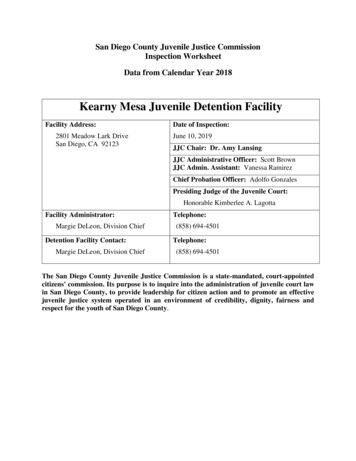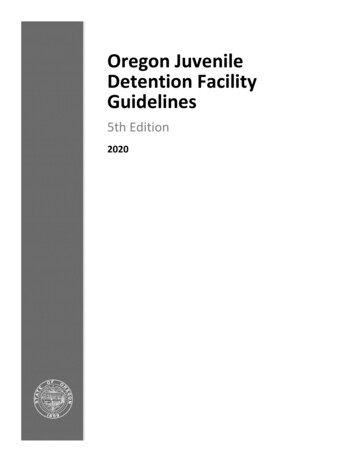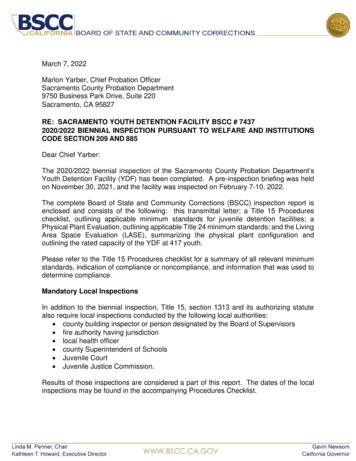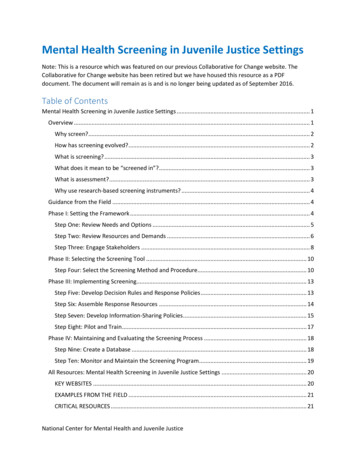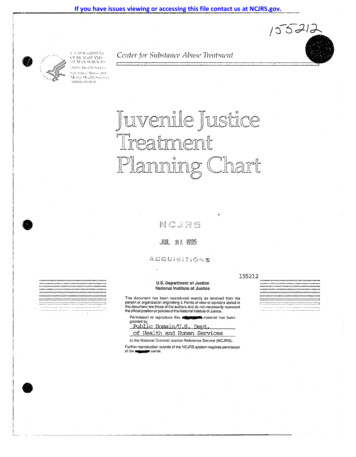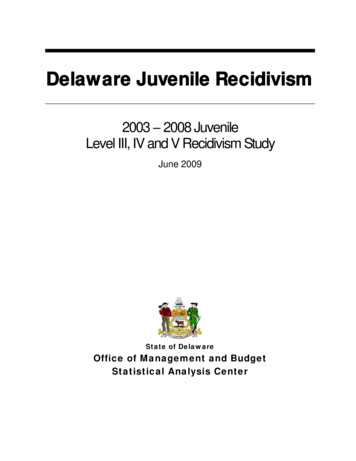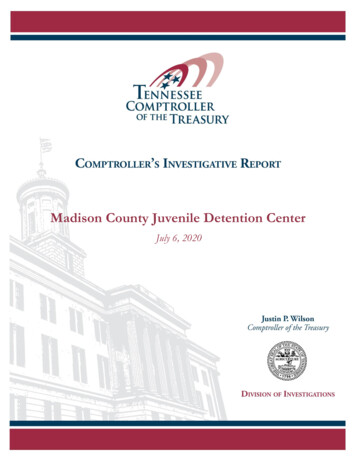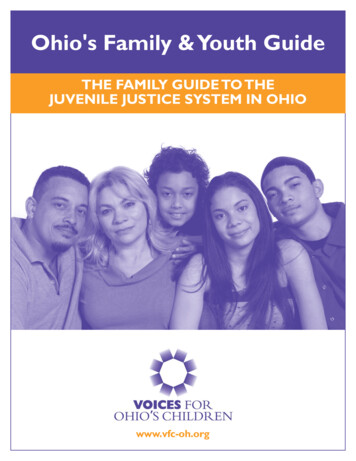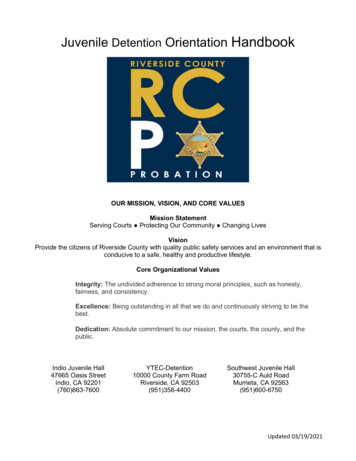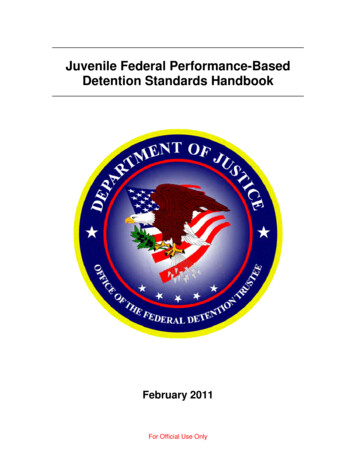
Transcription
Juvenile Federal Performance-BasedDetention Standards HandbookFebruary 2011For Official Use Only
Juvenile Federal Performance‐BasedDetention Standards HandbookINDEXA: ADMINISTRATION AND MANAGEMENTA.1A.2A.3A.4A.5Policy Development and Monitoring*Admission and OrientationJuvenile Detainee RecordsPersonal Property RetentionReleasesB: HEALTH CAREB.1B.2B.3B.4B.5B.6B.7C:SECURITY AND CONTROLC.1C.2C.3C.4C.5C.6C.7C.8C.9D.E:Security InspectionsSearchesAccountability and Supervision*Physical ControlSpecial Management HousingIncident ReportingJuvenile Abuse ReportingEmergency Planning*Standards of Conduct*FOOD SERVICED.1Management, Sanitation and Food StorageD.2Meals and Special DietsJUSTICEE.1E.2E.3E.4F:Health ScreeningsHealth Assessment and Access to Health Services*Special Medical Needs and ServicesMental Health ServicesSuicide PreventionServices and SupportHealth RecordsRights*Grievance ProcessRules and DisciplineAccess to CourtsSAFETY AND SANITATIONF.1F.2F.3F.4F.5Fire Safety*and Emergency Contingency PlansClothing and BeddingSanitation and HygienePhysical Facility and EquipmentControl of Hazardous Materials*For Official Use Only
G:SERVICES AND *Social ServicesReligious ServicesRecreation and ActivitiesWork ActivitiesReintegrationVisitationCorrespondence and MailTelephone UseAccess to Legal Materials and CounselWORKFORCE INTEGRITYH.1H.2H.3Staff Background and Reference ChecksStaff Training, Licensing and CredentialingStaff Misconduct* Key Elements/Mandatory* Elements highlighted in red within each function identify the minimumrequirements necessary to house USMS juvenile detainees.For Official Use Only
Federal Performance Based Detention Standards/JuvenileSection A: ADMINISTRATION AND MANAGEMENTA.1 Policy Development and MonitoringThe facility director ensures that current procedures for operating and maintaining thefacility are specified in a manual that is accessible to all employees, juvenile detainees,and the public.AcceptableDeficientRepeat DeficiencyReviewer’s initials:At‐RiskDate:On‐Site Assessment Items:Review facility’s written policies and procedures manual.Review documentation and interview staff to determine that policies and procedures arecommunicated to: Personnel.Juvenile detainees.Parents/legal guardians, when appropriate.Review documentation to ensure that policies and procedures are reviewed annually,updated as needed, and shared with staff prior to implementation.Interview staff to determine accessibility to necessary facility operations informationincluding: Policies and procedures.Post orders.Review policies and procedure to ensure that a policy exists which clearly states the facility willnot tolerate sexual abuse.For Official Use OnlyNot Applicable
Item No.Review ChecklistCommentsA.1.1A manual of policies and procedures exist.YNN/AA.1.2Policies and procedures are reviewed atleast annually and updated as needed. Thefacility director signs and dates each policy.YNN/AA.1.3Policies and procedures are communicated topersonnel, juvenile detainees and parents/legalguardian, when appropriate.YNN/AA.1.4Staff has access to post orders, policies andprocedures.YNN/AA.1.5Policy clearly states that the facility will nottolerate sexual abuse.YNN/AFor Official Use Only
Federal Performance Based Detention Standards/JuvenileSection A: ADMINISTRATION AND MANAGEMENTA.2 Admission and OrientationThe facility director ensures that all incoming juveniles undergo thorough screening andassessment, and receive an orientation to the facility’s procedures, rules, programs andservices.AcceptableReviewer’s initials:DeficientRepeat DeficiencyAt‐RiskDate:On‐Site Assessment Items:Review relevant policies and procedures for the admission and orientation of juveniledetainees. The procedures include: Determination that the juvenile detainee is legally committed to the facility. A complete search of the juvenile detainee and possessions. Disposition of personal property. Provision for a shower. Hair care. Issue of clean, laundered clothing, as needed. Issue of personal hygiene items. Medical, dental, and mental health screenings. Classification and assignment to housing unit which ensures sight and soundseparation from adult detainees. Recording of personal data. Assistance to juvenile detainees in notifying their families of admission. Written notification sent to parents/legal guardians to include visitationhours, mailing address, directions to the facility, complaint process, personalproperty policy, and how to contact the facility. Provision for written orientation materials translated in their preferredlanguage and appropriate reading level. Personnel assisting in the explanation of procedures.Review documentation that ensures policies and procedures are reviewed and updated at leastannually.Review written orientation material to ensure that information includes: Facility’s refusal to tolerate discrimination.Facility’s commitment to equality of access to programs and services withoutregard to race, gender, or national origin.Availability of an informal mechanism for juvenile detainees to bringproblems and questions (including complaints of victimization) to theattention of staff.The use of the formal grievance.For Official Use OnlyNot Applicable
Access to courts and legal representation.Pertinent rules and regulations.Personal property retention.Telephone and visiting privileges.Sick call procedures and access to health care.The facility’s plan and program for prevention, intervention and remediationof sexual misconduct, what constitutes sexual misconduct/sexualharassment, and the consequences of participating in such activities.How to report staff and detainee misconduct (and explanation of the extentto which such reporting is confidential and the appropriate agencycomponent that should be notified).Rules on appropriate interaction with staff.Interview staff and juvenile detainees to determine if juvenile detainees received theorientation information in a manner calculated for their understanding (i.e., reading ability,preferred language, and were given an opportunity to ask questions).Observe the admission and orientation process, when possible.For Official Use Only
Item No.Review ChecklistCommentsA.2.1Written policies and procedures exist forthe admission and orientation of juveniledetainee.YNN/AA.2.2Policies and procedures are reviewed atleast annually and updated as needed.YNN/AA.2.3Written orientation materials exist and areprovided to each juvenile detainee uponadmission.YNN/AA.2.4Juvenile detainees receive orientationinformation in a manner calculated fortheir understanding.YNN/AA.2.5Written notification of admission is sent toparents/legal guardians within 24 hours.YNN/AA.2.6Sight and sound separation from adultdetainees is maintained throughout thefacility.YNN/AFor Official Use Only
Federal Performance Based Detention Standards/JuvenileSection A: ADMINISTRATION AND MANAGEMENTA.3 Juvenile Detainee RecordsThe facility director ensures that juvenile detainee records are confidentially andsecurely maintained.AcceptableReviewer’s initials:DeficientRepeat DeficiencyAt‐RiskDate:On‐Site Assessment Items:Review relevant policies, procedures and practices governing the management ofjuvenile detainees’ records to include: The establishment, use, and content of records. Accountability for records. Preservation and schedule for retiring/destroying inactive records. Secure placement and maintenance. That all entries are dated and identified. The right to privacy.Review detainee records including: Confinement record (to include at a minimum classification documents,disciplinary record, escape history, and personal property inventory). Program/treatment record. Medical record (located in the medical section). Education record.Review detainee records’ sign‐in and sign‐out logs.Observe that physical juvenile records are marked “confidential.”Review policies and procedures for the release and transfer of juvenile detainee recordsto include the following: Records are safeguarded from unauthorized and improper disclosure. Juvenile detainees or their parents/legal guardians sign a release ofinformation consent form prior to release of information, as required bystate statute or regulation, and a copy of the form is maintained in thejuvenile detainee’s record.Review documentation of the release and transfer of detainee records.Interview staff to determine how released or transferred juvenile records are processed.For Official Use OnlyNot Applicable
Item No.Review ChecklistCommentsA.3.1Policies and procedures exist for themanagement of juvenile detainee records.YNN/AA.3.2Policies and procedures are reviewed atleast annually and updated as needed.YNN/AA.3.3All juvenile detainee records are securelyand confidentially maintained.YNN/AA.3.4Physical juvenile detainee recordsare marked “confidential.”YNN/AA.3.5Policies and procedures exist for therelease and transfer of juvenile detaineerecords.YNN/AA.3.6Released and transferred juvenile detaineerecords are archived and purged accordingstate/federal requirements.YNN/AA.3.7The release and transfer of juveniledetainee records are documented.YNN/AFor Official Use Only
Federal Performance Based Detention Standards/JuvenileSection A: ADMINISTRATION AND MANAGEMENTA.4 Personal Property RetentionThe facility director ensures the control and safeguarding of juvenile detainee personalproperty and monies.AcceptableReviewer’s initials:DeficientRepeat DeficiencyAt‐RiskDate:On‐Site Assessment Items:Review relevant policies and procedures for the collection, itemization, storage, andreturn of juvenile detainee personal property and funds.Interview staff and review juvenile detainee confinement records to determine that asystem for the tracking and secure maintenance of juvenile detainee personal propertyand funds is in place.Review documentation for an existing system in which juvenile detainees sign andreceive an itemized listing of their funds and stored property.Review documentation supporting the practice for the replacement of juvenile detaineeproperty destroyed or damaged, intentionally or inadvertently, by staff.Review documentation that the facility returns juvenile detainee personal property andfunds upon release and juvenile detainees sign for the receipt of property and funds.For Official Use OnlyNot Applicable
Item No.Review ChecklistCommentsA.4.1Policies and procedures exist for thecollection, itemization, storage, and returnof juvenile detainee personal property andfunds.YNN/AA.4.2Policies and procedures are reviewed atleast annually and updated as needed.YNN/AA.4.3A system is in place to track and securelymaintain juvenile detainee personalproperty and funds.YNN/AA.4.4Juvenile detainees sign and receive anitemized listing of stored property anddeposited funds.YNN/AA.4.5Policies and procedures exist to replace lost Yor destroyed juvenile detainee personalproperty.NN/AA.4.6Facility returns juvenile detaineespersonal property and funds at the time ofrelease and juvenile detainee signs forreceipt.YNN/AFor Official Use Only
Federal Performance Based Detention Standards/JuvenileSection A: ADMINISTRATION AND MANAGEMENTA.5 ReleasesThe facility director ensures juvenile detainees are released only with proper orders,identity verification, and notification.AcceptableReviewer’s initials:DeficientRepeat DeficiencyAt‐RiskDate:On‐Site Assessment Items:Review relevant policies and procedures for the release of juvenile detainees. Writtenprocedures include: Verification of identity. Verification of release papers. Completion of release arrangements, including person/agency to whomjuvenile is to be released. Completion of pending grievances and claims regarding lost personalproperty. Instructions for forwarding mail. Return of personal property and funds. Health care treatments and appointments for community follow‐up, asneeded. Transportation arrangements.Interview staff to determine if pertinent staff is notified of the impending juvenile detaineerelease.Observe the release process.Review confinement records of released juvenile detainees.For Official Use OnlyNot Applicable
Item No.Review ChecklistCommentsA.5.1Policies and procedures exist for therelease of juvenile detainees.YNN/AA.5.2Policies and procedures are reviewed atleast annually and updated as needed.YNN/AA.5.3Pertinent staff is notified of impendingreleases.YNN/AA.5.4Written procedures require:A.5.4aVerification of identity.YNN/AA.5.4bVerification of release papers.YNN/AA.5.4cCompletion of release arrangements, includingperson/agency to whom juvenile is to bereleased.YNN/AA.5.4dCompletion of pending grievances and claimsregarding lost personal property.YNN/AA.5.4eInstructions for forwarding mail.YNN/AA.5.4fReturn of personal property and funds.YNN/AA.5.4gHealth care treatments and appointments forcommunity follow‐up, as needed.YNN/AA.5.4hTransportation arrangements.YNN/AA.5.5Released juvenile detainee records are archivedand purged according to state/federalrequirements.YNN/AFor Official Use Only
Federal Performance Based Detention Standards/JuvenileSection B: HEALTH CAREB.1 Health ScreeningsThe facility director ensures medical, dental, and mental health screenings areperformed by trained, licensed health care professionals at intake, and that follow‐upaction is taken, when necessary.AcceptableReviewer’s initials:DeficientRepeat DeficiencyAt‐RiskDate:On-Site Assessment Items:*Review relevant policies, procedures and documentation concerning health screeningsand dispositions.*Review juvenile detainee medical records to determine if the following are identified,documented and addressed for health screenings: Screenings are performed within two hours of admission to the facility.Current medical/dental complaints, past medical/dental illnesses and priorhospitalizations.Emergency medical and dental needs.Chronic medical problems.Current medications or medication needs.Chronic medical problems.Mental health diagnosis and past hospitalizations for mental disorders.Current or past need for mental health treatment, especially in previousincarcerations.Inquiries into any known current or past thoughts of hurting or killingoneself.Condition of auditory or visual hallucinations.Alteration in state of consciousness or orientation to person, place or time.Signs of depression or agitation, abnormal behavior and appearance noted.PPD tuberculin skin test and/or chest radiograph is performed within 72hours of arrival.Screening for tuberculosis.Persons who have symptoms of tuberculosis are isolated and referred to ahealth care professional within the same day of identification of symptoms.Persons with positive tuberculin skin testing have a follow up healthassessment within 48 hours to include chest x‐ray and the provision ofmedications, if appropriate.Pregnancy testing for all females, with collection of information on currentand past pregnancies.Identification of symptoms of intoxication and withdrawal due to currentand prior drug, tobacco and/or alcohol use.For Official Use OnlyNot Applicable
Inquiry or assessment of risk of infectious diseases by history of cough,fever, rash, itching or skin lesions with appropriate isolation practices.Screening for sexually transmitted infections relevant to the communityprevalence.Current immunization status.Allergies and special dietary needs.Observation of skin and hair for infestations, bruises, tattoos, needlemarks, rashes or other lesions.Medical follow‐up which occurs the next business day if any non‐urgentmedical, mental or dental health issue is identified by the screening process.Interview staff and juvenile detainees to determine that health screening procedures arefollowed and to determine that: There is visual monitoring by staff through the completion of the healthscreen on newly admitted juvenile detainees.Juvenile detainees are provided the opportunity to report illness andemergent medical, mental and dental health needs.Appropriate medical referrals are made, as needed.Medical emergencies are handled immediately.Medical follow‐up occurs the next business day if any non‐urgent medical,mental or dental health issue is identified by the screening process.*Review staff training records and interview staff regarding training related to healthscreenings.Observe health screens to determine they are properly conducted in private andlanguage barriers and literacy are accounted for.For Official Use Only
Item No.Review ChecklistCommentsB.1.1Written policies and procedures exist thatprovide for receiving health screens withintwo hours of admission into the facility.YNN/AB.1.2Policies and procedures are reviewed atleast annually and updated as needed byhealth care and administrative staff.YNN/AB.1.3Policies provide for appropriately licensedand trained personnel to conduct screensand provide for necessary referral.YNN/AB.1.4Staff receives proper training regardinghealth screenings.YNN/AB.1.5Health screenings are performed properlyand language barriers and literacy areaccounted for.YNN/AB.1.6Appropriate follow‐up and referrals aremade upon the completion of healthscreenings.YNN/AB.1.7Emergency medical, dental and mentalhealth needs are identified, documentedand addressed.YNN/AFor Official Use Only
Federal Performance Based Detention Standards/JuvenileSection B: HEALTH CAREB.2 Health Assessment and Access to Health ServicesThe facility director ensures that juvenile detainees receive a comprehensive healthassessment and have full access to emergency and routine health services.AcceptableReviewer’s initials:DeficientRepeat DeficiencyAt‐RiskDate:On-Site Assessment Items:*Review relevant policies, procedures, health records and other documentationconcerning access to health care services and the completion of health assessments.*Review the juvenile detainee health record to determine if the following are included: Medical, dental and mental health screenings are completed within sevendays of admission to the facility, and previous medical records are available,if applicable.History of past and current illnesses, and risk behavior assessment.Vital signs, weight, height and body mass index.Physical examination appropriate to adolescents by a mid‐level provider, toinclude breast exam for females and testicular and genitourinary exam formales.Documentation of current immunizations with administration of AdvisoryCommittee on Immunization Practices (ACIP) recommended vaccines.Physical and sexual abuse history with mechanism for reporting, and clinicalfollow‐up established and practiced.Gynecological examination and Pap smears for females, as clinicallyappropriate.Clinically appropriate diagnostic testing, such as urinalysis, pregnancy test forfemales, TB skin testing, sexually transmitted disease screening, blood countand chemistry, etc.Allergies and chemical sensitivities.Determination of whether juvenile detainee’s medical circumstancespreclude the use of any force devices.Vision and hearing assessment.Chemical dependency.Psychiatric hospitalizations and treatment.Mental retardation.Cognitive impairments.Developmental disabilities.Mental status examination.Suicide risk determination.Documentation of emergency care.Documentation of palliative, prophylaxis and restorative dental care andtreatment by licensed dental provider.For Official Use OnlyNot Applicable
Provision of dental hygiene education.Provision of dental prophylaxis every six months.Provision for unimpeded access for juvenile detainees to make confidentialwritten medical, mental health, and dental complaints (sick call) to medicalstaff.Dispositions are formulated on results of assessments by the appropriatequalified medical staff.Documented provisions for people who wish to refuse the assessment.Health education that includes instruction on testicular self‐examination formales, breast self‐examination for females, and health promotion anddisease prevention appropriate to adolescents to include risk behaviorreduction messages.Interview staff and juvenile detainees to determine: Completion of all health assessments within seven days of admission to thefacility. Communication of information to other staff, by medical staff, regardingcircumstances that are impacted upon use of physical control, housing orprogramming for juvenile detainees. The provision of health education to juvenile detainees by medical staff. Access to all health care services and unimpeded sick call. Health access is unimpeded by administrative or security overrides (medicalautonomy).Observe sick call process and review documentation to determine that unimpededaccess occurs, requests are triaged within 24 hours, and appropriate clinical dispositionoccurs by health provider.*Review valid and current licenses/certifications of health care staff.*Observe completion of health assessments to determine they are properly conducted inprivate and language barriers and literacy are accounted for.Review health records and other documentation to determine: Records have appropriate signatures, dates and times.Health care disposition of juvenile detainees is based on their health status.Protocols and procedures for health assessments, including sick call, aredetermined by the responsible physician and meet recognized professionalstandards.Observe juvenile detainees during the tour that appear to have health needs,review those particular health records for disposition or the need for referral.For Official Use Only
Item No.Review ChecklistCommentsB.2.1Written policies and procedures exist forfull health assessments and sick call.YNN/AB.2.2Policies and procedures are reviewed atleast annually and updated as needed byhealth services and administrative staff.YNN/AB.2.3Full medical, dental and mental healthassessments of juvenile detainees arecompleted within seven days of theirarrival at the facility, unless there is areferral for an immediate full assessmentor emergency care at the time of theintake screening.YNN/AB.2.4All health care examinations andtreatment are conducted only byappropriate licensed health care staff.YNN/AB.2.5Regardless of housing assignment, juvenile Ydetainees have daily opportunities torequest health care, without the requestbeing transmitted by another detainee orcorrectional officer. Requests are madedirectly to health care staff.NN/AB.2.6Information regarding medicalcircumstances that impact upon use ofphysical control, housing or programmingfor juvenile detainees is communicated tosecurity or other staff.YNN/AB.2.7Evidence of medical autonomy exists.YNN/AB.2.8Juvenile detainees’ verbal and writtenrequests are received daily by health carestaff and triaged within 24 hours withappropriate disposition.YNN/AFor Official Use Only
Federal Performance Based Detention Standards/JuvenileSection B: HEALTH CAREB.3 Special Medical Needs and ServicesThe facility director ensures that juvenile detainees have full access to specialized healthcare services that require care beyond routine medical management. These juveniledetainees with special medical needs require and receive individualized treatment plans,specialty care and services.AcceptableReviewer’s initials:DeficientRepeat DeficiencyAt‐RiskDate:On-Site Assessment Items:Review relevant policies, procedures, health records and other documentationconcerning juvenile detainees requiring specialized health services including thechronically ill, communicable disease infections, the physically disabled, pregnant,terminally ill, developmentally delayed and victims of sexual assault.Review health records of juvenile detainees with special medical needs to determine: Enrollment in chronic care clinics in an appropriate time frame as determinedby the responsible physician, according to community clinical standards.Scheduled regularly to be seen as dictated by their illnesses and thecommunity standard of care.Emergency needs are handled promptly.Diagnostic testing is done in accordance with the identified chroniccondition.Medications and other treatments are provided as ordered and clinicallyindicated.If targeted physical examinations or evaluations are a part of the treatmentplan.If referred and evaluated by an obstetrician or qualified practitioner forprenatal care, if pregnant.Timely specialty consults, infirmary care and hospitalizations occur, asclinically appropriate.Preventive health care and health education are provided.Discharge planning for continued health treatment upon release is available.Treatment and appropriate isolation measures exist for those withcommunicable diseases.Treatment plans include instruction about diet, exercise, restrictions oradaptation to the correctional environment, medication, type and frequencyof diagnostic testing, frequency of follow‐up for medical evaluation andadjustment of treatment modality, and discharge planning for follow up inthe community.Review documentation for evidence of a multi-disciplinary review process regardinghousing assignments, work limitations, program assignments, discipline, and admissionsto and transfers from the institution, with written communication between the facilityFor Official Use OnlyNot Applicable
administrator and the responsible physician or designee regarding patients with specialhealth needs.Interview staff and review available records of juvenile detainees who have beensexually assaulted to determine if: A referral was made to a community facility for treatment and gathering ofevidence (as required).A history is taken.Evaluations are performed.Injuries are documented.Referrals were made to appropriate staff and services.Evidence is taken with detainee’s consent.Prophylactic treatment is provided, as necessary.Testing and counseling is provided, as necessary.Evaluation and referral to mental health professional was performed.Facility takes measures to protect victims from further assault by theirassailants.Required reporting occurred.For Official Use Only
Item No.Review ChecklistCommentsB.3.1Written policies and procedures exist forjuvenile detainees with specialized healthneeds.YNN/AB.3.2Policies and procedures are reviewed atleast annually and updated as needed byhealth services and administrative staff.YNN/AB.3.3Treatment plans are individualized andbased on clinical protocols according tothe community standard of care, withadherence to physician directed care.YNN/AB.3.4Documentation exists concerning requiredinfirmary care, hospitalizations andoutpatient care for juvenile detaineeswhen clinically indicated.YNN/AB.3.5Release discharge plans and medicalfollow up documented.YNN/AB.3.6Infection control measures are in placeand practiced.YNN/AB.3.7Sexual assaults are documented, treated,and reported appropriately.YNN/AB.3.8Juvenile detainees with special healthneeds are reviewed by a multi‐disciplinaryteam, and appropriate communication isrelayed to staff regarding use of force,housing or programming for juveniledetainees determined to have specialhealth needs.YNN/AFor Official Use Only
Federal Performance Based Detention Standards/JuvenileSection B: HEALTH CAREB.4 Mental Health ServicesThe facility director ensures that juvenile detainees have full access to and receivemental health services.AcceptableDeficientReviewer’s initials:Repeat DeficiencyAt‐RiskDate:On-Site Assessment Items:*Review relevant policies, procedures, medical protocols, health records and otherdocumentation concerning mental health services, including: assessments, therapeutictreatment, crisis stabilization, psychiatric hospitalization, psychotropic medication, andthe use of therapeutic restraints.Review health records to determine: All juvenile detainees receive a mental health screening within two hours ofadmission to the facility.Mental health screenings are reviewed by qualified mental healthprofessionals.Juvenile detainees with positive findings, indicated by the screening, areimmediately referred to a mental health professional for further evaluation.*Review mental health assessments (completed as a result of a positive mental healthscreening) to determine: Completion within seven days, or sooner, by a qualified mental healthprofessional when indicated by the results of the screening.History of current or past mental health diagnosis.Past hospitalizations for mental disorders.Current or past need for mental health treatment.Current or past thoughts of hurting or killing oneself or others.Current or past suicidal plans.History of suicidal or self‐injury attempts.Alteration in state of consciousness or orientation to person, place or time.History of trauma or abuse.Sexual offenses.Violent, aggressive or inappropriate behavior.Drug and/or alcohol use.Determination of mental retardation or developmental disability.Emergency psychiatric care and hospitalization.Review health records, mental health treatment plans, and other documentation todetermine that mental health services include therapeutic treatment (individual andgroup therapy), and is not limited to the use of psychotropic medication.For Official Use OnlyNot Applicable
Review documentation for evidence of a multi-disciplinary review process regardinghousing assignments, work limitations, program assignments, discipline, and admissionsto and transfers from the institution, with written communication between the facilitydirector and the responsible physician or designee regarding juvenile detainees withmental health needs.Review documentation and interview staff to determine the use of therapeutic restraintsis clinically justified and ordered or approved by the appropriate mental healthprofessional.Interview staff to determine: Delivery of mental health services, as appropriate.Multi‐disciplinary team approach in the development of mental healthtreatment plan
Reviewdocumentation supporting the practice for the replacementof juvenile detainee property destroyed or damaged, intentionally or inadvertently,by staff. Reviewdocumentation that the facility returns juvenile detainee personal property and funds upon release and juvenile detainees sign for the receipt of property and funds. For Official Use Only
